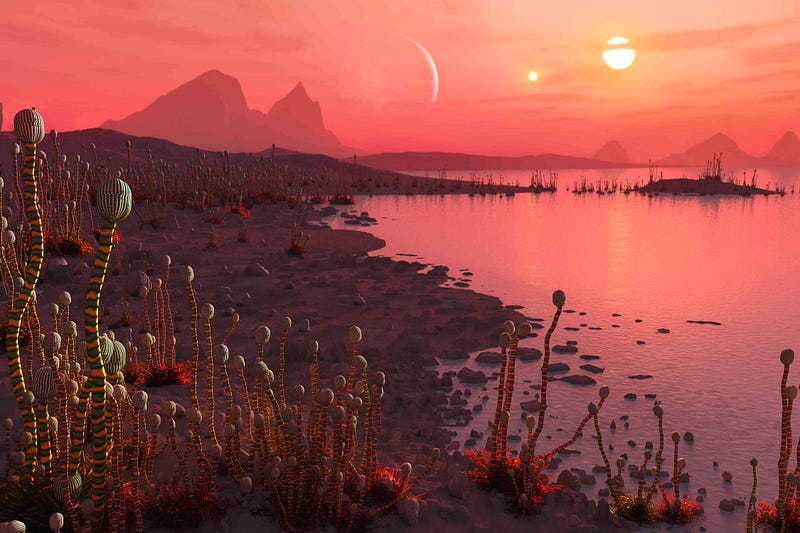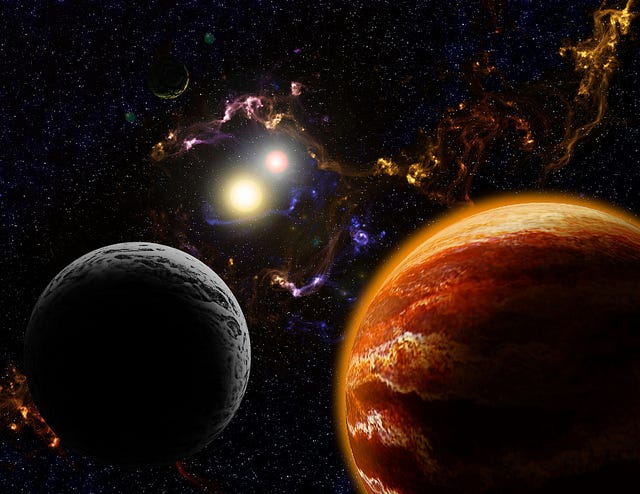Exploring the Potential for Life Around Binary Stars
Written on
Chapter 1: The Harsh Beginnings of Young Stars
Young stars endure a turbulent existence in the stellar nurseries from which they emerge, often encountering other stellar bodies during their formative years. Recent studies suggest that this dynamic environment could actually increase the chances of life developing on such worlds.
The habitable zone surrounding a star, frequently referred to as the "Goldilocks zone," is where conditions are just right—not too hot and not too cold—for liquid water to exist. Water is essential for life as we know it, making it more probable for life to arise on other planets. As binary stars interact with nearby stars, their gravitational forces can pull them closer together, effectively expanding the habitable zone and enhancing the potential for life within the system. “Our model indicates that there are more binary systems with planets located in Goldilocks zones than previously thought, thereby boosting the prospects for life. The worlds often imagined in science fiction—where two suns illuminate alien landscapes—are now much more plausible,” said Bethany Wootton, who conducted this research as an undergraduate at the University of Sheffield.

Chapter 2: Investigating Binary Systems
University of Sheffield researchers employed computer simulations to explore the influence of neighboring stars on young stars in stellar nurseries. Their findings reveal that binary stars can be drawn closer together by the gravitational pull of passing stars, which in turn can enlarge their habitable zones. In a typical cluster of about 350 binary systems, this phenomenon could potentially impact up to 20 systems, with some habitable zones overlapping, thereby further increasing the likelihood of life.

Approximately one-third of stars in the galaxy exist in systems with two or more stars, and this ratio rises among younger stars. Certain pairs are so closely linked that they exchange material, while others are distanced by thousands of astronomical units (AU)—the average distance from Earth to the Sun. Many stars are also part of more complex systems, including triples or even larger groupings.
Despite the chaotic gravitational forces in multi-star systems, planets can maintain stable orbits if they are located sufficiently close to their parent stars. “A planet will retain a stable long-term orbit in a binary system as long as it orbits one of the stars within one-third of the distance between the two,” explained Dr. Richard Parker, also from the University of Sheffield. This means that while interactions can bring stars nearer, there remain stable orbital zones—including within the habitable zone—where planets can thrive.

Life is most likely to emerge on planets situated within the habitable zones of their stars, where conditions are ideal for liquid water to exist. Just 35 years ago, astronomers were unaware of any planets existing beyond our Solar System. Today, over 3,000 exoplanets have been identified orbiting other stars, with multiple planets found in binary systems for the first time in 2012 using the Kepler spacecraft.
“Unlike our sun, many stars belong to multiple-star systems. The critical question has always been whether they host planets and planetary systems. Our ongoing search for habitable planets has revealed even more opportunities for life to emerge,” stated William Borucki, principal investigator of the Kepler mission at NASA’s Ames Research Center.
Similar to the desert planet Tatooine from Star Wars, any life forms on planets orbiting binary stars would experience day and night in a unique manner. “The most significant difference would be having two ‘suns’ in the sky, resulting in two sunrises and two sunsets. However, the timing of each star's rise and set could differ, leading to varied day lengths,” Wootton explained in an exclusive discussion with The Cosmic Companion.
The Transiting Exoplanet Survey Satellite (TESS), launched in April 2018, aims to continue the quest for exoplanets, building on the discoveries made by the Kepler mission. However, it won’t be able to address the critical question regarding the interactions that may have influenced the proximity of host stars in the past. “While Kepler has already identified planets in habitable zones around stars and discovered planets in binary systems, missions like TESS will uncover many more. Yet, we won’t know if the stars were pushed closer together due to past interactions,” Dr. Parker noted.
Interestingly, our Sun may have originated near the remnants of an ancient supernova explosion. While such an event would have been catastrophic for life on Earth today, it may have contributed to the internal heating that was crucial for the development of life here. Ongoing research will delve into the lives of young stars to determine if similar dramatic events can enhance the likelihood of life formation.
Chapter 3: Habitable Zones and Binary Stars
This video titled "Do Habitable Zones Exist Around Binary Stars?" explores the conditions necessary for life in binary star systems.
In "Binary Stars Could Stabilize Planets to Be Habitable!", learn how binary star systems may create stable environments conducive to life.